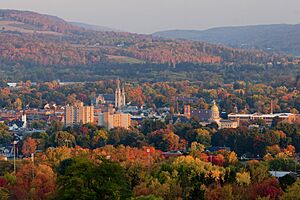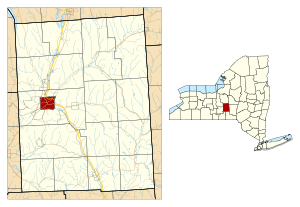Cortland, New York facts for kids
Quick facts for kids
Cortland, New York
|
|
|---|---|

Cortland, New York, from its Southside
|
|

Location in Cortland County and the state of New York
|
|
| Country | United States |
| State | New York |
| County | Cortland |
| Settled | 1791 |
| Incorporated (village) | 1853 |
| Rechartered | 1864 |
| Incorporated (city) | 1900 |
| Government | |
| • Type | Mayor-Council |
| Area | |
| • Total | 3.91 sq mi (10.14 km2) |
| • Land | 3.89 sq mi (10.09 km2) |
| • Water | 0.02 sq mi (0.05 km2) |
| Elevation | 1,129 ft (344 m) |
| Population
(2020)
|
|
| • Total | 17,556 |
| • Density | 4,508.47/sq mi (1,740.74/km2) |
| Time zone | UTC-5 (Eastern (EST)) |
| • Summer (DST) | UTC-4 (EDT) |
| ZIP code |
13045
|
| Area code(s) | 607 |
| FIPS code | 36-18388 |
| GNIS feature ID | 0947499 |
Cortland is a city in New York, located in the Southern Tier region. It is the main city and county seat of Cortland County, New York. People sometimes call Cortland the "Crown City." In 2020, about 17,556 people lived there.
The city of Cortland is surrounded by the town of Cortlandville. It sits near the western edge of Cortland County.
Contents
History of Cortland
The city of Cortland is named after Pierre Van Cortlandt. He was the very first lieutenant governor of New York.
How Cortland Grew
Cortland was first settled in 1791. It became a village in 1853 and then a city in 1900. This made it New York's 41st city. When Cortland County was created in 1808, Cortland became its main town.
Cortland is known as the "Crown City" because it's in a flat area where seven valleys meet. It is about 1,130 feet (344 meters) above sea level. The city's official seal shows 40 stars. These stars represent the 40 cities that became cities before Cortland. The seven points on the crown stand for the seven valleys around Cortland. A 41st star in the middle of the crown shows that Cortland is close to the center of New York State.
Early Industries and Important Places
In the late 1800s and early 1900s, the main business in Cortland was the Wickwire Brothers wire mill. They made wire for things like window screens. The Wickwire family built two amazing homes. One, the Victorian-style home of Chester Wickwire, is now a museum called the 1890 House Museum. Charles Wickwire's home is now used by the SUNY Cortland Alumni Association.
Cortland was also home to Brockway Motor Company. This company started in 1875 making carriages. Later, it became a truck maker. It was bought by Mack Trucks in 1956 and closed in 1977. The city still holds a yearly show for Brockway trucks.
From 1960 to 1992, Smith Corona typewriters were made in Cortland.
The city has a unique octagon house. The Cortland Rural Cemetery is designed like a garden and is still used today.
Education in Cortland
In 1868, the Cortland Normal School opened here. This school grew over time into a four-year college. Today, it is known as the State University of New York at Cortland (SUNY Cortland). It offers many different programs and research opportunities.
Recent History
In 2006, Cortland's old clock tower caught fire and was destroyed. But it was rebuilt later. The new building now has both businesses and apartments.
Many buildings in Cortland are listed on the National Register of Historic Places. This means they are important historical sites.
People from Cortland
Many interesting people have connections to Cortland:
- Carl Carmer, an author.
- William Dillon, a composer and singer.
- Ronnie James Dio, a famous singer for bands like Rainbow and Black Sabbath. There's even a street named Dio Way in Cortland!
- Nancy Duffy, a news personality and founder of the Syracuse St. Patrick's Day Parade.
- Col. Arnald Gabriel, who led the US Air Force Band.
- Milo Goodrich, a former US congressman.
- Charles W. Goodyear, a businessman who owned railroads.
- Leidy Klotz, a retired soccer player, professor, and author.
- Jim Mahady, a former baseball player for the New York Giants.
- Dennis Mepham, a retired soccer player.
- Nathan Lewis Miller, a former governor of New York.
- Gideon C. Moody, a former senator for South Dakota.
- Mark Nauseef, a musician.
- Alton B. Parker, who ran for president in 1904.
- Sime Silverman, a publisher.
- Eric Soderholm, a former professional baseball player.
- Elmer Ambrose Sperry, an inventor who created the gyroscopic compass. He held over 400 patents! A ship, the USS Sperry, is named after him.
- Aljamain Sterling, a professional mixed martial arts (MMA) fighter and former UFC bantamweight champion.
- Joel Eric Suben, a composer and conductor.
- Raymond Gram Swing, a journalist.
- Samuel Ringgold Ward, an African-American who escaped slavery and became an important abolitionist and minister.
- Spiegle Willcox, a jazz trombone player and composer.
- Gary Wood, a former NFL quarterback.
Geography of Cortland
Cortland is located in the west-central part of Cortland County. It is about halfway between the cities of Syracuse and Binghamton.
The city covers an area of about 3.91 square miles (10.14 square kilometers). Most of this area is land. The Tioughnioga River flows south past the city. This river is a branch of the Susquehanna River.
Getting Around Cortland
Roads and Highways
Several major roads pass through or near Cortland. Interstate 81, U.S. Route 11, and New York State Route 281 are main roads that run north and south. New York State Route 13 and New York State Route 41 also serve the city.
You can reach Syracuse in about 40 miles (64 km) north on I-81. Binghamton is also about 40 miles (64 km) south on I-81. NY-13 goes southwest about 18 miles (29 km) to Ithaca.
Bus Services
Cortland has its own local bus service called Cortland Transit. For longer trips, you can use Greyhound and Trailways of New York buses. These connect Cortland to Syracuse, Binghamton, and other places. OurBus also offers connections to Binghamton and New York City. The closest train station is in Syracuse.
Air Travel
For air travel, there is the Cortland County Airport just west of the city. The nearest airport with commercial flights is Ithaca Tompkins International Airport.
Climate in Cortland
Cortland has a humid continental climate. This means it has cold, snowy winters and warm summers.
| Climate data for Cortland, New York | |||||||||||||
|---|---|---|---|---|---|---|---|---|---|---|---|---|---|
| Month | Jan | Feb | Mar | Apr | May | Jun | Jul | Aug | Sep | Oct | Nov | Dec | Year |
| Record high °F (°C) | 68 (20) |
65 (18) |
85 (29) |
90 (32) |
93 (34) |
96 (36) |
100 (38) |
98 (37) |
100 (38) |
90 (32) |
81 (27) |
68 (20) |
100 (38) |
| Mean daily maximum °F (°C) | 30.6 (−0.8) |
32.8 (0.4) |
41.9 (5.5) |
54.1 (12.3) |
67.6 (19.8) |
76.3 (24.6) |
81.0 (27.2) |
79.4 (26.3) |
70.7 (21.5) |
59.0 (15.0) |
46.2 (7.9) |
35.1 (1.7) |
56.2 (13.5) |
| Mean daily minimum °F (°C) | 15.2 (−9.3) |
15.7 (−9.1) |
24.1 (−4.4) |
34.4 (1.3) |
45.3 (7.4) |
54.3 (12.4) |
58.8 (14.9) |
56.9 (13.8) |
49.3 (9.6) |
39.3 (4.1) |
31.7 (−0.2) |
21.5 (−5.8) |
37.2 (2.9) |
| Record low °F (°C) | −25 (−32) |
−26 (−32) |
−13 (−25) |
11 (−12) |
23 (−5) |
32 (0) |
39 (4) |
35 (2) |
27 (−3) |
18 (−8) |
2 (−17) |
−17 (−27) |
−26 (−32) |
| Average precipitation inches (mm) | 2.74 (70) |
2.49 (63) |
3.12 (79) |
3.22 (82) |
3.28 (83) |
4.08 (104) |
3.37 (86) |
2.98 (76) |
3.97 (101) |
3.17 (81) |
3.49 (89) |
3.41 (87) |
39.32 (999) |
| Average snowfall inches (cm) | 19.7 (50) |
19.2 (49) |
13.2 (34) |
4.0 (10) |
0 (0) |
0 (0) |
0 (0) |
0 (0) |
0 (0) |
.3 (0.76) |
8.2 (21) |
22.3 (57) |
86.9 (221) |
| Average precipitation days (≥ 0.01 in) | 17.4 | 14.3 | 14.3 | 13.4 | 12.1 | 11.8 | 10.6 | 10.2 | 11.5 | 12.6 | 15.2 | 16.8 | 160.2 |
| Average snowy days (≥ 0.1 in) | 9.1 | 7.0 | 4.5 | 1.7 | 0 | 0 | 0 | 0 | 0 | .1 | 3.2 | 7.6 | 33.2 |
| Source 1: NOAA (normals 1971–2000), | |||||||||||||
| Source 2: The Weather Channel (extremes) | |||||||||||||
Population of Cortland
| Historical population | |||
|---|---|---|---|
| Census | Pop. | %± | |
| 1870 | 3,066 | — | |
| 1880 | 4,050 | 32.1% | |
| 1890 | 8,590 | 112.1% | |
| 1900 | 9,014 | 4.9% | |
| 1910 | 11,504 | 27.6% | |
| 1920 | 13,294 | 15.6% | |
| 1930 | 15,043 | 13.2% | |
| 1940 | 15,881 | 5.6% | |
| 1950 | 18,152 | 14.3% | |
| 1960 | 19,181 | 5.7% | |
| 1970 | 19,621 | 2.3% | |
| 1980 | 20,138 | 2.6% | |
| 1990 | 19,801 | −1.7% | |
| 2000 | 18,740 | −5.4% | |
| 2010 | 19,204 | 2.5% | |
| 2020 | 17,556 | −8.6% | |
| U.S. Decennial Census | |||
In 2000, there were 18,740 people living in Cortland. About 18.3% of the population was under 18 years old. The average age of people in the city was 28 years.
Sports in Cortland
Cortland has been a training spot for professional sports teams. From 2009 to 2014, the New York Jets football team held their training camp at the SUNY Cortland campus. This brought many visitors to the city. It also helped the local economy by bringing in millions of dollars. The Jets later moved their camp back to their own facility in New Jersey.
Images for kids
See also
 In Spanish: Cortland (Nueva York) para niños
In Spanish: Cortland (Nueva York) para niños

